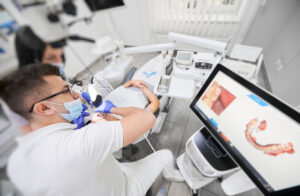In the healthcare sector, we use increasingly connected glasses, specifically models called «Augmented Reality (AR) smartglasses» because of their transparent lenses (to be opposed to «Virtual Reality smartglasses» which are closed systems).
The most highlighted use case is remote assistance for surgery. The goal is to provide remote support to a surgeon for the execution of a specific procedure: information displayed in front of his/her eyes (and no longer on a remote screen) as well as live explanations provided remotely by a specialist can improve the surgical operation. This help can be provided by professionals based anywhere in the world.
Although this is a technological breakthrough, it may still take a few years before this solution is deployed on a large scale, as there are many processes to implement beforehand.
Yet connected glasses with transparent lenses can be used more easily and broadly in healthcare specific areas, where, combined with suitable software solutions, they already demonstrated interesting performances.
Examples of usages in different health sectors include:
Radiology:
In the healthcare community, a lot of video feedbacks or images are displayed on external screens, often positioned next to the control machines or the computers used for the procedures.
In the case of radiologists, it is common for these screens to be located behind a counter, or even in another room; the technician must then move back and forth to check information, what can be a significant waste of time and energy.
With a pair of connected AR glasses and the use of a simple application, the livestream video appears in front of the radiologist’s eyes; This allows the specialist to study the scanned content from anywhere in the room, and even while remaining next to the patient. This allows him to optimize the time spent with each of them and improve his own comfort.
Dentistry:
In the case of dentists, the use case’s benefits are enhanced by the latent position of the dentist that can create musculoskeletal disorders (Safety & Health Magazine, November 2021).
When using a dental scanner, the practitioner must turn around regularly to evaluate the result of each action, on a screen often located for practical reasons in his back, or even in another room.
The use of connected glasses, combined with the scanner and a related application, can facilitate these operations, and leave the dentist focused on his/her action, the scan’s rendering appearing in real time in front of his eyes.
Interestingly, connected glasses can have a completely different use in the dentist’s office, and become a real asset for managing difficult patients. It is indeed estimated that almost 36 per cent of adults in the world have some fear about visiting the dentist. Of this percentage, about 4 per cent of these people have never been to the dentist because of their strong fear (Biospace market research, September 2018).
Using glasses can help them relax; watching short videos, film clips or relaxation programs can be an innovative and practical solution; the dentist can perfectly treat the patient using the glasses, while not feeling isolated thanks to the transparent lenses.
Such optimized solutions already exist and can facilitate the dentist’s life in case of recalcitrant people!

Ophthalmology:
In the field of vision in general, there are now a few software solutions that have been developed and optimized on AR connected glasses; some of them can even improve the life of people affected by pathologies such as age-related macular degeneration (AMD), macular oedema, retinopathy, macular dystrophia…
Some of these solutions are experimental, but others are deployed and now available on the market.
There are even small promising companies, which have emerged in recent years, that have developed applications for the visually impaired or even “legally blind” people (See definition : Braille Institute).
These technological developments based on AR connected glasses use high-performance software, and they allow to restore autonomy to people affected by these pathologies at an advanced stage.
Medicine:
The medical desert is a real problem in many countries around the world. To manage the doctors’ shortage, especially outside large cities, it may be useful to consider the use of remote solutions to support young doctors, nurses; they can then receive remote help from an experienced physician sitting in his office to solve difficult problems faced in the field.
In this case, the AR connected glasses can be particularly useful, because when combined with a remote support software, they send live video feedback from the camera of what the medical staff sees, and the doctor can make decisions and explain the actions to be taken. The hands-free function of the glasses allows the medical assistant to perform the physician’s instructions in real time.
These solutions, widely used in the industry, have been slightly adapted to the healthcare world but the benefits are the same: compensate for the lack of staff, help new entrants, make the medical staff in the field more versatile by getting real time support.
Paramedics also use these new tools to provide first aid in emergency situations.
In conclusion, it would be unjustified to limit the potential use of AR connected glasses to surgery. Many applications and use cases exist that really deserve to be studied and can potentially be deployed right now for the benefit of users in all healthcare departments!
If you are interested in any of these use cases, and would like more information on existing solutions, please contact us – contact@reapse-consulting.com
